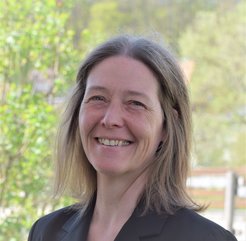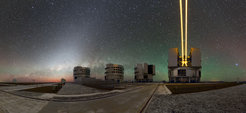Funding procured to uncover the inner workings of galaxies at cosmic noon
MPE scientist Natascha Förster Schreiber wins ERC Advanced Grant
The European Research Council today announced the winners of its 2021 Advanced Grants competition. Among the leading researchers funded across Europe is MPE scientist Natascha Förster Schreiber for her project GALPHYS to explore galaxies at cosmic noon.

In lookback studies, astronomers have assembled a fairly complete census of galaxies over 85% of cosmic time, back to when the age of the Universe was only about 2 billion years. The bulk of stars, which today reside in massive elliptical and spiral galaxies, formed rapidly until the cosmos was about 6 billion years old (or between redshifts z~1-3) – an epoch often dubbed “cosmic noon”. Most of this star formation took place in massive, gas-rich, turbulent disks, in which dense bulges, fast growing central black holes, and galactic winds were ubiquitous.
The next frontier is to uncover the physical mechanisms inside the galaxies that govern the buildup of stars and the emergence of galactic structure. This goal is achievable only by resolving the motions and distributions of gas on scales of 1 kpc or less spatially and 10-20 km/s in velocity. At cosmic noon, galaxies were very rich in gas; and this gas fragments into kpc-scale complexes, in which stars are formed – at least 10 times bigger than such complexes in today’s spirals. Yet, to study galaxies on this fundamental scale at a distance of 6 billion light-years or more, at redshift z>1, astrophysicists need powerful instrumentation delivering much sharper views than typically achieved so far.

Major improvements in observing sensitivity and resolution now make this possible: in 2022, the most advanced near-IR adaptive optics-assisted integral field spectrograph ERIS will start operations at the ESO VLT. Led by MPE scientist Natascha Förster Schreiber, the ERC project GALPHYS centers on an ambitious observation program with ERIS using 90 nights of Guaranteed Time. In addition, it will exploit key synergies with cutting-edge millimeter interferometry at IRAM/NOEMA and ALMA.
For the first time, GALPHYS will systematically study the structure, radial gas inflows and outflows, and gravitational instabilities in the rapidly growing, massive gas-rich galaxies in the young Universe. The team will directly address several of the most important, outstanding issues in galaxy evolution: How are mass and angular momentum efficiently transported in early disks? Where does their elevated gas turbulence originate? What is the nature of giant star-forming complexes and how do they evolve? What is the role of outflows powered by stellar and AGN feedback? GALPHYS will provide an unmatched benchmark of lasting legacy in galaxy evolution studies.
The research of Natascha Förster Schreiber centers on the properties and evolution of galaxies. Already for her Master thesis at the Université de Montréal she studied the galaxy M82, and extended her observations of the starburst galaxy in her PhD thesis carried out at the Max Planck Institute for Extraterrestrial Physics in Garching. As Postdoc, she went to CEA Saclay, France, and the Leiden Observatory in the Netherlands, before returning to MPE in 2004 and undertaking studies of the kinematics of distant galaxies. She was a Minerva Fellow of the Max Planck Society from 2008-2012. The University of Bath, United Kingdom awarded her a Honorary Doctor of Science (Hon DSc) degree in 2019.













